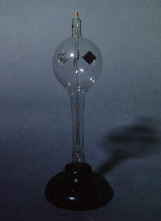
24 x 9.5
Glass, wood and silver
CAT. 1878: 810
Radiometro de Geissler.
Geissler radiometer.
In 1873, Crookes published a paper in the Philosophical Magazine in which he reported his work on the mechanical effects produced by luminous radiation.
The instrument he used in his experiments comprised a needle suspended by a wire, with small balls or blades made from glass, carbon, elder pith, ivory, various metals, etc., at its ends. The needle with the spheres was encased inside a hollow glass ball and the suspension wire extended down a glass tube.
Crookes observed that the bodies at the ends of the needle could be attracted by a warm body placed at the ends of the vessel containing the needle. This phenomenon was observed as soon as the gas inside the vessel approached atmospheric pressure.
He also saw that the blades could be repelled by the heated body when the pressure of the surrounding gas was relatively low. This behaviour depended on the nature of the surface of the blades, as well as on the pressure of the gas. If the face turned towards the body was black, the repulsion was more intense
After this work, Crookes placed four blades at the ends of the four arms of a reel. This could turn freely on a vertical axis. Each blade had one darkened face and the other reflective. The reel rested on the tip of a steel needle by means of a concave piece of glass. The convex face of the glass penetrated the concave end of a glass rod, without touching it. This mechanism was designed to prevent the reel falling when the instrument was being moved.
When exposed to visible electromagnetic radiation, or to infrared radiation, the reel turned at a speed which depended on the intensity of the light source. Crookes was attempting to measure the intensity of the radiation by means of the rotation speed of the reel, which was why the apparatus was called a radiometer.
The apparent attraction produced by the heat of the radiation, when the gas pressure inside was close to atmospheric pressure, is explained by the heating of the black surface of the blades, causing the upward movement of the surrounding gas. There was thus a lessening of the pressure exerted by the gas on this side of the blade, resulting in the attraction of the warm body. This explanation was confirmed by many other experiments carried out by M. Niecens.
Dewar and Tait demonstrated that there was a difference of temperature between the two faces of the same blade, after being submitted to radiation, when one of them had a black coating and the other was reflective.
The behaviour of Crookes' radiometer was later explained according to Bernoulli's theory, which held that gaseous fluids were composed of molecules moving in straight lines, in all directions. These molecules, on colliding with the walls of a solid, exerted a pressure which depended on the temperature of the gas.
The increase in temperature observed on one of the faces of the blade corresponded to an increase in the "life force" of the molecules of the gas nearby. If the pressure within the radiometer approximated the atmospheric pressure, the probability of molecules colliding with one another was quite high, and the "life force" would be transferred among them. A less effective action on the blade arose from the collision of gas molecules among one another. The hotter face would cause an upward movement in the gas molecules closest to the blade. This upward movement observed near the black face of the blade was accompanied by a lessening of pressure on that side of it, a dual effect causing the reel to start moving.
If the air is extracted from the radiometer, the probability of collision among the molecules would be considerably reduced. Transference of the "life force" would thus be less important. The impact of the molecules on the black face of the blades would thus be more violent. This phenomenon is only seen at the black face, since this has a higher temperature than the reflective face. The reel is thus subjected to an opposite dual action to that observed in the previous conditions and, therefore, the movement is in the opposite direction.
Daguin, Pierre-Adolphe, Traité Élémentaire de Physique Théorique et Expérimentale, Paris, 1878, Vol. IV, n.os 2695 and 2698.